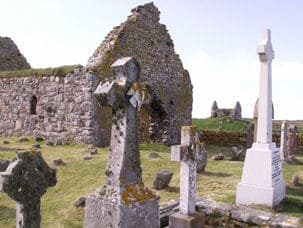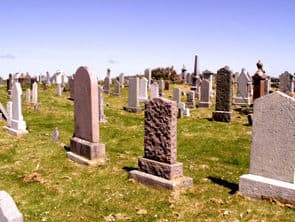Tiree Graveyards Gravestones & Inscriptions
Ancient Chapels and Burial Grounds in Tiree
In their
Handbook to the Islands of Coll and Tiree
(c.1937), Hector MacDougall & Rev. Hector Cameron noted that practically every township in Tiree had an ancient shrine or chapel, and beside the chapel there was usually a burial ground. Today there is little above-ground evidence of most of them, but the sites of some are known from surviving ruins, old documents, or excavations. The descriptions below in black italics are from MacDougall & Cameron's
Handbook,
and those in red italics are from Donneil Kennedy's (1994) book
The Land Below the Waves: The Island of Tiree, Past and Present.
Three of the old burial grounds are in current use - the two burial grounds at Kirkapol, in the eastern half of the island, and the burial ground at Soroby, near Balemartine, in the western end of the island.
Kirkapol - Chapels & Burial Grounds
Two of the three burial-grounds still used on the island are here, and are separated only by a few yards. The one is Cladh Odhrain (Oran's Graveyard) and An Cladh Beag (The Little Graveyard). There is the foundation wall of a chapel that once stood at the former; but in Cladh Beag there is a wonderfully preserved chapel of seven or eight hundred years ago. To whom it was dedicated is not definitely known. One has heard different names given to it – St Peter's, St Kenneth's and St Columba's. A more ancient chapel stands on a rocky eminence about 150 yards to the north of it. It is more probably that which was dedicated to St Columba, and to which Ayg MacPetris was appointed by the Pope in 1375. Round this little chapel there is no churchyard. Soroby - Chapel & Burial Ground It was at Soroby, that the first Christian establishment was instituted. It was, during St Columba's time, ruled by St Baithene. Of the chapel that existed at Soroby in post-Columban years not a vestige now appears above ground. There is a record of a monastery being established near here by St Columba's cousin, St Batheine, in 565. There is no trace of the original building but the churchyard there is still in use. There is a record of the destruction of the monastery by fire in 673, but this appeared to be no deterrent. Various medieval artifacts are known to have survived, and several slabs and stones were moved to Cladh Beg – Kirkapol – burial ground. [An Iodhlann's 2003 publication Island of Two Harvests: A Historical Guide to the Island of Tiree notes that although it is usually thought that the site of the monastery was at Soroby it is equally likely to have been at Kirkapol near the old chapels.] Scarinish – St Thomas's Chapel & Burial Ground The Chapel of St Thomas was the ancient church of Scarinish and was situated, with its burying ground, immediately to the north-west of the village about 60 yards from the road leading north. Not a vestige of it now remains. Hynish – Chapel & Burial Ground The site of Hynish's ancient chapel is about half a mile west of the farmhouse. To whom it is dedicated is not known, and An Cladh Beag (G. The little burying ground), a name which still survives, is almost the only indication of its existence. Balephuil – Chapel On the eastern shoulder of Cnoc-Ghrianail, one of the peaks of Ben Hynish, there is a flat grassy area with the foundations of an ancient building in the center. This is in the form of an oval measuring some 12 feet by 18 feet. The shape and dimensions suggest the site of an ancient chapel. Kenavara (Ceann a' Mhara) – St Patrick's Chapel Under the shadow of Kenavara Hill and surrounded by rocks, only the foundations and part of the east gable of this ancient shrine are left to tell the tale of other days. But close to the chapel there stand two pillars of stone, each with an incised Latin cross on both sides. Traces of several huts have been found nearby, and the whole settlement is within an enclosure. It is thought to have been an early monastery with chapel building added later. Barrapol/Middleton – Chapel & Burial Ground There was an old Christian burial ground, Cnoc a' Chlaidh [Gaelic = Hill of the burial ground], between Barrapol [Norse = Town of the burial mound] and Middleton. A curious sight adjoins it on the south. It consists of a level circle of 12 yards diameter, strewn thickly with small broken stones. In the centre is another circle only 4 feet across. This last is literally paved with large rounded quartz pebbles, and these edged round with ordinary water-worn stones of a large size. The whole must have been a large burial-cairn, of which these scattered ruins are the strange remains. Dr Reeves in his monograph of Tiree (1854) states that close to this site there were some cabins which were built with the stones of the chapel that stood there. Kilkenneth – St Kenneth's Chapel & Burial Ground The chapel, the remains of which still stand, was dedicated to St Kenneth, the founder of the monastery of Aghaboe in Ireland. He was the intimate friend of St Columba. The chapel measures 28 feet 9 inches by 13 feet 9 inches. On the north and east it is practically buried in drifted sand. The winter gales discover many human remains around it. The distinct remains of a wall from north to south-east of the chapel marks the graveyard attached to it. Kilmoluaig – Chapel & Burial Ground Kilmoluaig (Cell of Moluac) derives its name from the church that was situated at Croish. There is scarcely a trace of it now remaining, but from time to time human remains have been discovered at the spot which denotes its undoubted graveyard. The stones of this chapel have been removed to make room for the plough, as well as for building purposes. Cornaigmore – Kilbride [St Bride's] Chapel & Burial Ground A quarter of a mile south of the mill and a like distance east of Loch Bhasapol, in the stackyard of Lag nan Cruach farm is the site of Kilbride Chapel and graveyard. Many of the stones that marked the graves are lying about, but there is not a trace of the chapel itself to be seen. Kenovay - St Finan's Chapel & Burial Ground The site of St Finan's Chapel and burial ground is … less than a quarter of a mile from the shore. This site is clearly marked, the chapel being 22 ft by 11½ ft inside. The grave mounds stand out clearly, and one is struck with the smallness of these. Local tradition here seems to be correct when it says that only unbaptized children were buried there, the last burial taking place about 120 years ago [i.e. about 1815]. This restricted child-burial … was probably a latter day custom or regulation, the probability being that at first both old and young found here their last resting-place. Balephetrish – Chapel or Monastery East of Balephetrish Hill is a gentle slope… on the ordnance survey map a church marked there is called Cill Fhinnain (St Finan's). Excepting a few large stones that probably denote the site of a building somewhat circular in shape there is nothing to show where this church building stood. It is suggested that the edifice was really the monastery founded by Findchan, which Adamnan mentions in his "Life of St Columba". Caolas – Chapel of the Cross (Crois a' Chaolis) & Burial Ground Only the faintest traces remain of the ancient burial ground of Crois a' Chaolis. These are in a small enclosure by the roadside, half a mile from the ferry which formerly existed between Tiree and Coll. There is neither material evidence nor tradition of the chapel, which Reeves informs us stood at this spot. But on the other side of the road, opposite the burial ground, there are two large stones embedded in the soil, and between these the cross is said to have stood. |

